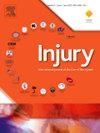Optimizing patient selection for ECMO after pediatric hypothermic cardiac arrest
IF 2.2
3区 医学
Q3 CRITICAL CARE MEDICINE
Injury-International Journal of the Care of the Injured
Pub Date : 2025-01-01
DOI:10.1016/j.injury.2024.111731
引用次数: 0
Abstract
Background
In 2004, our level 1 regional pediatric trauma center created a protocol to activate ECMO for children with suspected hypothermic cardiac arrest based on inclusion criteria: serum potassium ≤9, submersion <90 min, and core body temperature <30 °C. In 2017, Pasquier et al. developed a model to help predict the survival of adults after hypothermic cardiac arrest (HOPE score) that has not been validated in children. We sought to apply this score to our pediatric patient population to determine if it can optimize our patient selection.
Methods
This was a retrospective review of all patients cannulated onto VA ECMO for hypothermic cardiac arrest between 2004 and 2022. We used abstracted data points to calculate the HOPE score for our patient population, both with and without presumed asphyxia.
Results
Over 19 years, 18 patients were cannulated for suspected hypothermic arrest, with three survivors (17 %). The HOPE score survival prediction ranged from 1 to 86 % with presumed asphyxia and 6–98 % without presumed asphyxia. Survivor HOPE scores ranged from 9 to 86 % with presumed asphyxia and 42–98 % without presumed asphyxia. Non-survivors’ scores ranged 1–29 % with asphyxia and 6–57 % without asphyxia. A cutoff of >5 % predicted survival with asphyxia for ECMO could have decreased our cannulations by half without missing survivors.
Conclusion
ECMO can be a lifesaving measure for specific children after hypothermic arrest. However, identifying the patients that will benefit from this resource-intensive intervention remains difficult. HOPE score utilization may decrease the rate of futile cannulation in children, but multi-centered research is needed in the pediatric population.
优化小儿低体温心脏骤停后 ECMO 患者的选择。
背景:2004 年,我们地区一级儿科创伤中心制定了一项协议,根据纳入标准(血清钾≤9,浸没方法)为疑似低体温心脏骤停的儿童启动 ECMO:这是对 2004 年至 2022 年期间因体温过低心脏骤停而插管至 VA ECMO 的所有患者的回顾性研究。我们使用摘录的数据点来计算患者群体的 HOPE 评分,包括假定窒息和未假定窒息的患者:结果:19 年间,18 名患者因疑似低体温骤停而插管,其中 3 人存活(17%)。根据 HOPE 评分预测的存活率,推测窒息患者的存活率为 1% 至 86%,未推测窒息患者的存活率为 6% 至 98%。幸存者的 HOPE 分数在 9% 到 86% 之间,其中有假定窒息,42% 到 98% 没有假定窒息。非幸存者的得分范围为 1-29% 有窒息,6-57% 无窒息。如果 ECMO 的预测存活率大于 5%,我们的插管量就会减少一半,而不会漏掉存活者:结论:对于低体温骤停后的特定儿童来说,ECMO 是一项挽救生命的措施。结论:ECMO 可以挽救低体温骤停后特定儿童的生命。然而,确定哪些患者将从这种资源密集型干预中获益仍然很困难。使用 HOPE 评分可降低儿童的无用插管率,但需要在儿童群体中开展多中心研究。
本文章由计算机程序翻译,如有差异,请以英文原文为准。
求助全文
约1分钟内获得全文
求助全文
来源期刊
CiteScore
4.00
自引率
8.00%
发文量
699
审稿时长
96 days
期刊介绍:
Injury was founded in 1969 and is an international journal dealing with all aspects of trauma care and accident surgery. Our primary aim is to facilitate the exchange of ideas, techniques and information among all members of the trauma team.

 求助内容:
求助内容: 应助结果提醒方式:
应助结果提醒方式:


